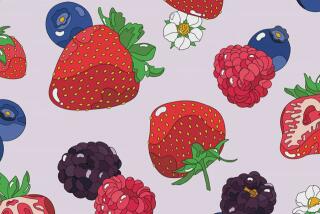Buy This Now: Figs, with 12 recipes

Figs, for all of their luscious glory, may be the single most peculiar fruit on the planet.
Let’s begin with the obvious – that they’re not really a fruit at all, but a collection of flower blossoms, turned inside out. Yes, you read that right. That dripping center is actually made up of flower parts, and each of those little crunches you hear when you bite into a fig is a tiny seed.
That’s just the start. Because the fig is a flower turned inside out, there are obvious complications with pollination. For many figs, that can only be accomplished by one type of very tiny wasp. It enters the fig through a tiny hole in the base; after depositing its pollen on the hidden flowers, it retreats the same way.
VIDEO: How to choose the best fresh figs
Why don’t we find ever the occasional wayward wasp in our figs? Because any wasps that loiter too long are dissolved by a powerful protein-dissolving enzyme called ficin that’s produced naturally by figs.
Yet so powerful is the allure of fresh figs that even knowing all of that does nothing to diminish our ardor. It is difficult to write about the experience of devouring a truly ripe fig without veering into pornography.
Generally, figs can be divided into two classes: green and black. For the most part in California, you’re going to want to choose the black ones — Mission and Brown Turkey — which are more reliably sweet. Most green figs are varieties that were chosen for drying, and they tend to be a little dull.
If you find green Adriatics, though, snatch them up. They’re exquisite. Possibly even better are Panachèe, or Tiger, figs, which are actually starting to show up at some supermarkets. These are gorgeous, with vertical lemon and lime stripes on the peel and a sweet soft center that looks and tastes like raspberry jam.
How to choose: Figs are quite fragile, and because they don’t continue ripening after harvest, choosing them is a balancing act. You want them soft and ripe but not smashed. A few tears in the skin will be just fine, though. Real fig lovers say to look for a drip of moisture in the little hole at the bottom of the fruit. Smell is important too. There shouldn’t be any whiff of fermentation.
How to store: Figs are so delicate they really should be refrigerated; they can start to spoil within a few hours of being harvested.
Are you a food geek? Follow me on Twitter: @russ_parsons1
VIDEO: Here’s how to choose the freshest produce
More to Read
Eat your way across L.A.
Get our weekly Tasting Notes newsletter for reviews, news and more.
You may occasionally receive promotional content from the Los Angeles Times.











